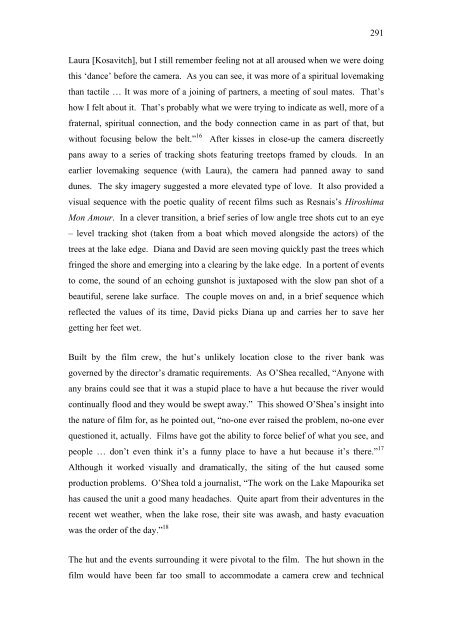Copyright Statement - ResearchSpace@Auckland
Copyright Statement - ResearchSpace@Auckland
Copyright Statement - ResearchSpace@Auckland
Create successful ePaper yourself
Turn your PDF publications into a flip-book with our unique Google optimized e-Paper software.
291<br />
Laura [Kosavitch], but I still remember feeling not at all aroused when we were doing<br />
this ‘dance’ before the camera. As you can see, it was more of a spiritual lovemaking<br />
than tactile … It was more of a joining of partners, a meeting of soul mates. That’s<br />
how I felt about it. That’s probably what we were trying to indicate as well, more of a<br />
fraternal, spiritual connection, and the body connection came in as part of that, but<br />
without focusing below the belt.” 16 After kisses in close-up the camera discreetly<br />
pans away to a series of tracking shots featuring treetops framed by clouds. In an<br />
earlier lovemaking sequence (with Laura), the camera had panned away to sand<br />
dunes. The sky imagery suggested a more elevated type of love. It also provided a<br />
visual sequence with the poetic quality of recent films such as Resnais’s Hiroshima<br />
Mon Amour. In a clever transition, a brief series of low angle tree shots cut to an eye<br />
– level tracking shot (taken from a boat which moved alongside the actors) of the<br />
trees at the lake edge. Diana and David are seen moving quickly past the trees which<br />
fringed the shore and emerging into a clearing by the lake edge. In a portent of events<br />
to come, the sound of an echoing gunshot is juxtaposed with the slow pan shot of a<br />
beautiful, serene lake surface. The couple moves on and, in a brief sequence which<br />
reflected the values of its time, David picks Diana up and carries her to save her<br />
getting her feet wet.<br />
Built by the film crew, the hut’s unlikely location close to the river bank was<br />
governed by the director’s dramatic requirements. As O’Shea recalled, “Anyone with<br />
any brains could see that it was a stupid place to have a hut because the river would<br />
continually flood and they would be swept away.” This showed O’Shea’s insight into<br />
the nature of film for, as he pointed out, “no-one ever raised the problem, no-one ever<br />
questioned it, actually. Films have got the ability to force belief of what you see, and<br />
people … don’t even think it’s a funny place to have a hut because it’s there.” 17<br />
Although it worked visually and dramatically, the siting of the hut caused some<br />
production problems. O’Shea told a journalist, “The work on the Lake Mapourika set<br />
has caused the unit a good many headaches. Quite apart from their adventures in the<br />
recent wet weather, when the lake rose, their site was awash, and hasty evacuation<br />
was the order of the day.” 18<br />
The hut and the events surrounding it were pivotal to the film. The hut shown in the<br />
film would have been far too small to accommodate a camera crew and technical















